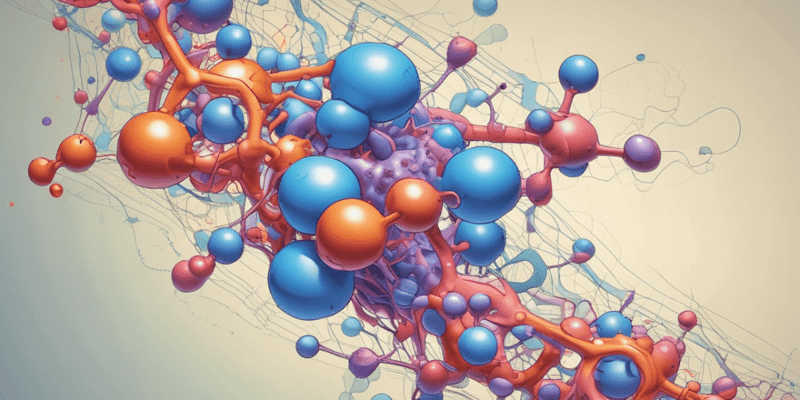22 Questions
What is the purpose of cell fractionation?
To isolate organelles and macromolecules from a cell
What is the result of disrupting cells through various methods?
The breakage of some cell membranes, leaving organelles intact
What is the first step in subcellular fractionation?
Homogenization
What property is used to separate subcellular fractions during cell fractionation?
Mass, surface, and specific gravity
What is the purpose of using an isotonic buffer when cutting tissue?
To stop pH changes and osmosis
What is the result of cell fractionation?
The separation of homogeneous sets of organelles
What is the result of homogenization of cells?
Cells are mechanically disrupted and broken
What is an advantage of using cell fractionation to study organelles?
It allows for the study of processes within organelles
What is the purpose of filtering the tissue after grinding?
To remove insoluble tissue
What is the purpose of centrifugation at low speeds?
To pellet nuclei
What is the term for the suspension of cells and their component parts after disruption?
Extract
What is the purpose of density gradient centrifugation in cell fractionation?
To further separate and purify subcellular fractions
What is the purpose of increasing the centrifugation speed?
To sediment particles of lower densities
What organelle is typically pelleted at medium speeds?
Mitochondria
What was isolated for the first time in 1934?
Mitochondria
What is the purpose of differential centrifugation?
To separate organelles and macromolecules
What is the purpose of centrifugation in fractionation?
To separate components that differ greatly in size
What is the primary method of preventing convective mixing during velocity sedimentation?
Using a shallow gradient of sucrose
What is the name of the process by which various components in a mixture move as distinct bands through a salt solution?
Velocity sedimentation
What type of homogenization involves the use of enzymes such as lysozyme and chitinase?
Enzymatic homogenization
What is the name of the instrument used to achieve a finer degree of separation during centrifugation?
Ultracentrifuge
What is the purpose of layering the homogenate as an arrow band on top of a dilute salt solution?
To achieve a finer degree of separation during centrifugation
Study Notes
Fractionation of Cells and Analyzing Their Molecules
- Cells are disrupted and their organelles and macromolecules are isolated in pure form to study certain organelles from a cell.
- Methods of cell disruption include osmotic shock, ultrasonic vibration, forced through a small orifice, or grinding up cells, which break many of the cell membranes.
- Careful application of disruption procedures leaves organelles such as nuclei, mitochondria, the Golgi apparatus, lysosomes, and peroxisomes largely intact.
Cell Fractionation
- Cell fractionation is the process of breaking up a cell and separating its components and organelles to observe them in isolated form.
- Methods involve the homogenization or destruction of cell boundaries by different mechanical or chemical procedures, followed by the separation of the subcellular fractions according to mass, surface, and specific gravity.
Steps of Subcellular Fractionation
- Homogenization
- Differential centrifugation
- Further separation and purification by density gradient centrifugation
- Collection of fractions
- Analysis of fractions
Homogenization or Cell Disruption
- Chemical methods: alkali, organic solvents, detergents
- Enzymatic methods: lysozyme, chitinase
- Physical methods: osmotic shock, freeze/thaw
- Mechanical methods: sonication, homogenization, French press
Centrifugation
- Centrifugation is the first step in most fractionations, but it separates only components that differ greatly in size.
- A finer degree of separation can be achieved by layering the homogenate as an arrow band on top of a dilute salt solution that fills a centrifuge tube.
- Velocity sedimentation is the process of components moving as distinct bands through the salt solution at different rates.
- Density gradient centrifugation is used to achieve a finer degree of separation.
Isolation of Components of Living Cells
- Low speed centrifugation is used to separate intact cells from medium.
- High speed centrifugation can be used to separate subcellular components.
- The first isolation of mitochondria was done in 1934 by Bensley.
- The first chemical analysis of mitochondria was done in 1937.
Ultracentrifugation
- Ultracentrifugation made it possible to isolate pure fractions of nucleus, nucleolus, mitochondria, lysosomes, microsomes, and ribosomes.
- We have obtained our knowledge on the molecular composition of cell components through ultracentrifugation.
This quiz covers the methods of examining cells, including fractionation of cells and analyzing their molecules, isolating organelles and macromolecules in pure form.
Make Your Own Quizzes and Flashcards
Convert your notes into interactive study material.
Get started for free



